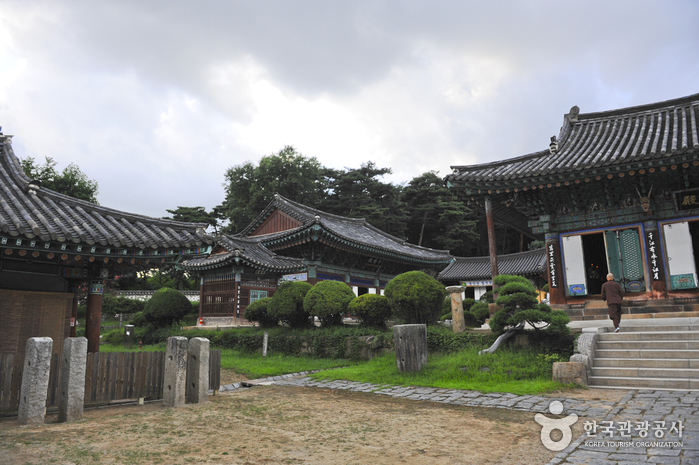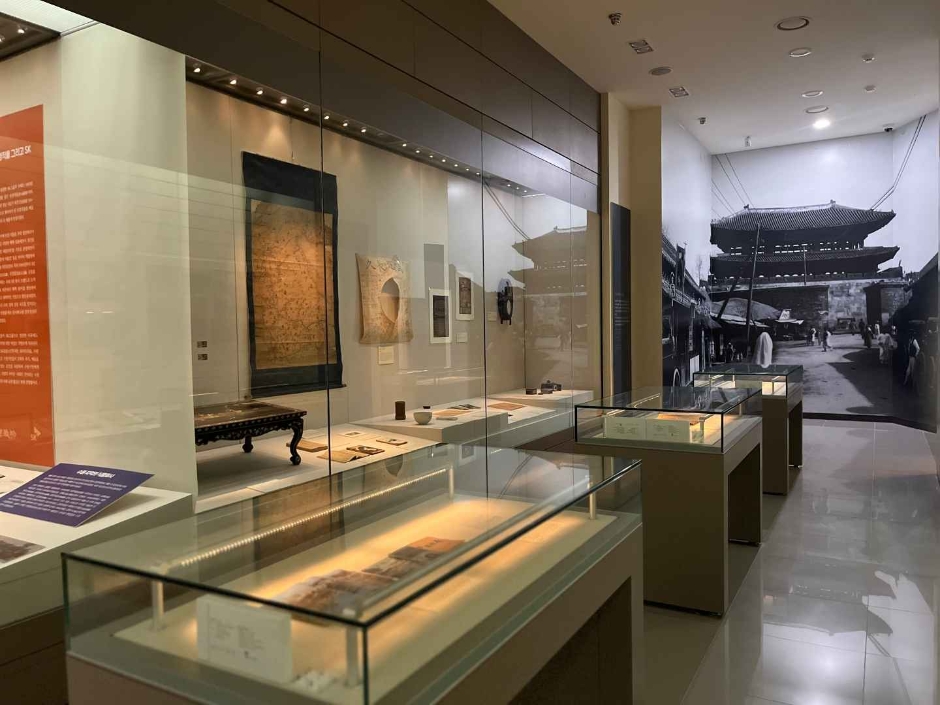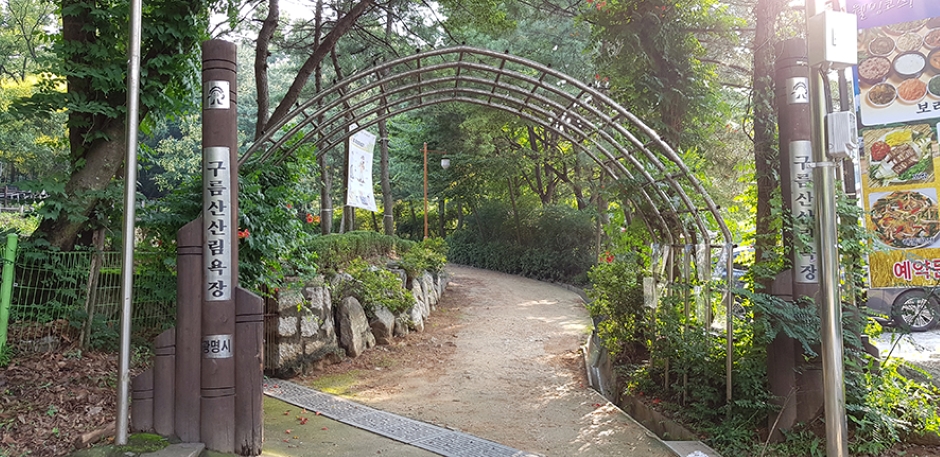Homeplus - Dongsuwon Branch [Tax Refund Shop] (홈플러스 동수원)
17.7Km 2024-04-19
257, Hyowon-ro, Paldal-gu, Suwon-si, Gyeonggi-do
-
Hwaseong Yongjusa Temple (용주사(화성))
17.7Km 2021-12-21
136, Yongju-ro, Hwaseong-si, Gyeonggi-do
+82-31-234-0040
Yongjusa Temple is located near Yungneung and Geolleung Royal Tombs. This site was originally the location of Garyangsa Temple, which was constructed in 854, during the 16th year of King Munseong of the Silla Kingdom. The temple was very famous as it was surrounded by beautiful mountains and crystal clear waters. However, the temple was destroyed by fire during the Manchu War of 1636.
During the Joseon dynasty, King Jeongjo moved the tomb of his father to this spot, and built Yongjusa Temple here to pray for the repose of his father’s soul. It is said that one night before the temple was completed, King Jeongjo dreamt of a dragon ascending to the sky holding a magic ball in its mouth. He therefore named the temple “Yongjusa,” which means the temple of a dragon with a magic ball in Korean.
The courtyard of the temple contains the Bronze Bell of Yongjusa Temple, a National Treasure; a stone pagoda; Daeungbojeon (the main hall); and Cheonboru Pavilion. Visitors to Yongjusa Temple can also find the “Bumoeunjunggyeong” books, which were written by King Jeongjo on the subject of filial affection and respect for one’s parents. These days, Yongjusa Temple and the Yungneung and Geolleung Royal Tombs are highly valued for their cultural heritage.
Suwon Museum (수원박물관)
17.8Km 2025-05-22
265 Changnyong-daero, Yeongtong-gu, Suwon-si, Gyeonggi-do
+82-31-228-4150
Locaed in Iui-dong, Yeongtong-gu, Suwon Museum has one basement floor and two above-ground floors, spanning over an area of 6,535 ㎡. Suwon Museum consists of two main exhibition halls, Suwon Museum of History and Calligraphy Museum of Korea, showcasing approximately 48,000 relics, and a planned exhibition hall for special occasions and exhibitions.
Suwon Museum of History recreates a scene of Yeongdong Market Street during the1960s. Children can learn and get secondhand experience of what Suwon was like in the past while adult visitors can reminisce the old times.
Calligraphy Museum of Korea is the first calligraphy museum built by a local government. The museum houses Korea's significant calligraphy works. The hall features a spacious area and its display cases are designed with cutting edge technology to highlight the relics on display. Exhibited collections include geumseokmun (metal writing), beopseo (calligraphic specimen of renowned artists of the past), works of renowned calligraphers during the Joseon dynasty, eopil (the writings of Kings), seogan (letters), works of renowned contemporary calligraphers, and more. Also, a planned exhibition hall holds exhibitions with specific themes every year. In addition, the museum offers educational programs for visitors as well as large scale calligraphy events for the general public.
Artbox - Suwon Ingye Branch [Tax Refund Shop] (아트박스 수원인계)
17.9Km 2024-04-22
175, Gwongwang-ro, Paldal-gu, Suwon-si, Gyeonggi-do
-
Olive Young - Suwon Town Branch [Tax Refund Shop] (올리브영 수원 타운)
17.9Km 2024-06-27
1F, 169, Gwongwang-ro, Paldal-gu, Suwon-si, Gyeonggi-do
-
Sammaksa Temple (삼막사)
17.9Km 2024-02-07
478 Sammak-ro, Manan-gu, Anyang-si, Gyeonggi-do,
Sammaksa Temple is a Buddhist temple located in Samseongsan Mountain. Legend has it that the temple was established in 667 by Wonhyo, a Buddhist philosopher from the Silla era. Within the temple grounds are Cheonbuljeon Hall, Yukgwaneumjeon Hall, Myeongbujeon Hall, Manghaeru Pavilion, Chilbogak House, among others. The temple holds heritages like the Rock-carved Buddha Triad and the Fertility Stones. These artifacts, symbolizing the fusion of Buddhism and folk religion, highlights the ancient nature of the place.
SI Jaju - Suwon Ingye Branch [Tax Refund Shop] (SI 자주 수원인계)
17.9Km 2024-04-19
197, Gwongwang-ro, Paldal-gu, Suwon-si, Gyeonggi-do
-
Olive Young - Suwon City Hall Station Branch [Tax Refund Shop] (올리브영 수원시청역)
17.9Km 2024-04-22
138, Gwongwang-ro, Paldal-gu, Suwon-si, Gyeonggi-do
-
Gold & Gem - Triple Street Branch [Tax Refund Shop] (골드앤젬 트리플ST)
17.9Km 2024-04-22
Store #B104a-1, Block D, B1, 33-4, Songdogwahak-ro 16beon-gil, Yeonsu-gu, Incheon
-
Gureumsan Forest Park (Gureumsan Urban Forest Park) (구름산 산림욕장 (구름산 도시자연공원) )
17.9Km 2024-04-08
27 Ori-ro 619beon-gil, Gwangmyeong-si, Gyeonggi-do
Gureumsan Forest Park is densely populated with trees that are 20 meters high. The forest park has a playground and wooden benches, and has the highest phytoncide concentration out of all the 13 forest parks in Gyeonggi-do. This hiking trail has been developed with 356 fir trees and an 184-meter red clay trail to provide citizens and tourists with a relaxing barefoot walking experience. Most of the forest paths in the park area are covered in wood chips, making it easier to walk.
![Homeplus - Dongsuwon Branch [Tax Refund Shop] (홈플러스 동수원)](http://tong.visitkorea.or.kr/cms/resource/70/2889070_image2_1.jpg)


![Artbox - Suwon Ingye Branch [Tax Refund Shop] (아트박스 수원인계)](http://tong.visitkorea.or.kr/cms/resource/45/2888445_image2_1.jpg)

![SI Jaju - Suwon Ingye Branch [Tax Refund Shop] (SI 자주 수원인계)](http://tong.visitkorea.or.kr/cms/resource/32/2889532_image2_1.jpg)
![Olive Young - Suwon City Hall Station Branch [Tax Refund Shop] (올리브영 수원시청역)](http://tong.visitkorea.or.kr/cms/resource/23/2888423_image2_1.jpg)

 English
English
 한국어
한국어 日本語
日本語 中文(简体)
中文(简体) Deutsch
Deutsch Français
Français Español
Español Русский
Русский